The goal in a Snugword puzzle is to pack the lettered pieces together, forming
the correct answer for each row in the puzzle. In this example, the answer
for each of the six rows is a chemical element. Each clue gives the atomic
number for the intended answer. There are 13 pieces, each containing three
letters. Some letters have a pink background, which indicates they belong in
the first column (i.e. they are the initial letters of the answers).
The tiling grid is also shown, as dotted lines inside the answer area. When
solved, the pieces will fit together in that tiling arrangment.

To solve the puzzle, we'll need to drag the pieces into the
appropriate positions. Suppose we know that HYDROGEN has atomic number 1, so
that would be the answer to the fifth row. The first piece in the row must be
an L-shaped piece that contains an H in the upper left. We type H to
highlight all the pieces that contain an H. There are two of them.

Only one of those pieces has the right shape. So we grab that and
drag it into place.

Once we place all the pieces for HYDROGEN, the green light next to the
row lights up. This tells us we have the right answer for that row. Those
pieces also form the answer to the 6th row— NITROGEN.
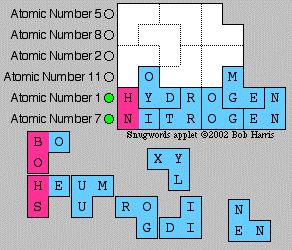
At this point we have two letters in the fourth row. This might be
enough for us to figure out the fourth row. But instead, we notice that one
shape has only two pieces left— the ones with XYL and ROG. Looking at the
diagram for where these pieces go, we notice that one of them has to form the
second and third letters of the second row. We can't think of any elements
that start out with _RO, but we notice that OXYGEN would work with the XYL
piece. So we place it. If it's wrong we can drag it back out later.
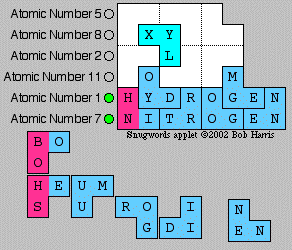
We're able to place the rest of the tiles for OXYGEN, and we also
discover the answer for the first row— BORON.
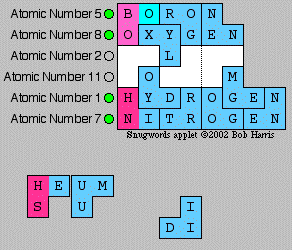
At this point, the piece containing DII is forced, as it is the only
piece of that shape remaining.
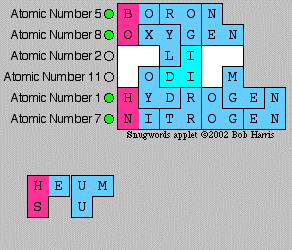
Further, even though the two remaining pieces have the same shape, one of them
has pink and must go in the first column.
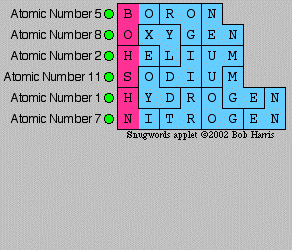
The puzzle is now completely solved.
Note that many of the features shown in this example are optional.
For example, not all of the puzzles indicate initial letters, some puzzles
don't show the tiling grid, and some don't even give any clues. Further, some
puzzles will have some answers or partial answers already given to you.
Others will contain black cells to indicate spaces between words.
Back to the main Snugwords page











